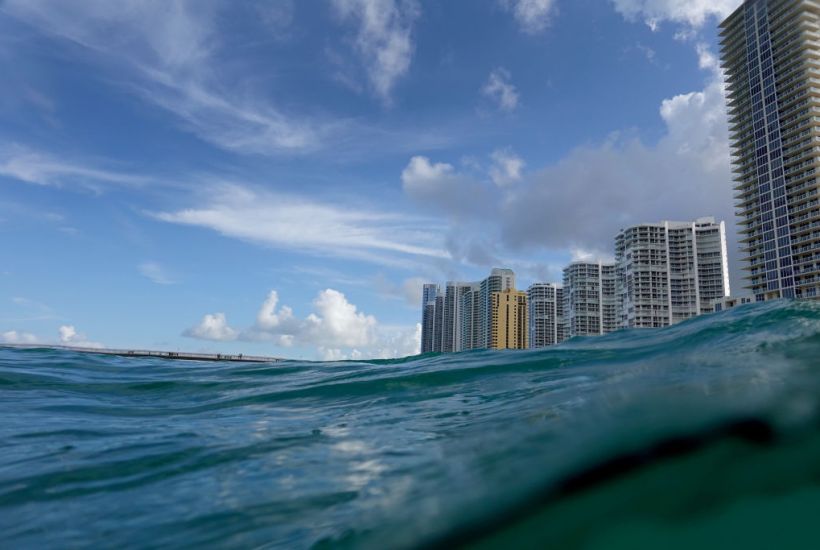Predictably enough, the UN’s Intergovernmental Panel on Climate Change report has been greeted with hyperbole about fire, flood and tempest. It is ‘code red for humanity,’ according to UN general-secretary Antonio Guterres. ‘This report must sound a death knell for coal and fossil fuels before they destroy our planet.’
As ever with IPCC reports, the content doesn’t live up to the hysterical reviews. If the vision presented in it were the basis of a disaster movie you would want your money back.
No, it doesn’t say that the German floods were caused by man-made climate change – something implied by much of the press coverage, which used photos of the damage in Rhineland towns to illustrate the publication of the report. What it says – to quote from the ‘summary for policymakers’ – is that ‘Globally averaged precipitation over land has likely increased since 1950, with a faster rate of increase since the 1980s (medium confidence)’ – in other words we think, but we are not all that sure, that the world is experiencing higher rainfall. Somehow, that gets converted by some into an assertion that climate change has created an event such as the German floods out of nothing.
But the summary for policymakers is itself a distilled version which omits many of the complex changes observed in the climate over the past century, the uncertainties and caveats surrounding these – and the efforts to compare these changes with what has happened in the past few thousand years so as to judge whether they might be accounted by natural variability. These are published in the body of the report. Perhaps the most interesting section relates to storms. Over the past few years, it has become common practice to blame any storm on man-made climate change. TV reports on the subject almost invariably carry footage of palm trees being bent over by lashing winds of a tropical storm.
Yet the assertion that we are experience greater storms is not supported by the evidence in the IPCC report. The report finds evidence that storm tracks have shifted polewards over the past 70 years. But this is what it says, in chapter 2:
‘..the total number of extratropical cyclones has likely increased since the 1980s in the NH (low 10 confidence), but with fewer deep cyclones particularly in summer. The number of strong extratropical cyclones has likely increased in the southern hemisphere (medium confidence). The extratropical jets and cyclone tracks have likely been shifting poleward in both hemispheres since the 1980s with marked seasonality in trends (medium confidence). There is low confidence in shifting of extratropical jets in the NH during the mid-Holocene and over 950–1400 CE to latitudes that likely were similar to those since 1979.’
In other words, the northern hemisphere is experiencing more storms, but fewer deep ones. They tend to track a slightly higher latitude than they did 40 years ago but there is some evidence that this trend was also evident during medieval times, before large scale burning of fossil fuels.
As for tropical monsoons, the report says:
‘observed trends during the last century indicate that the GM precipitation decline reported in AR5 [the last IPCC report] has reversed since the 1980s, with a likely increase mainly due to a significant positive trend in the northern hemisphere summer monsoon precipitation (medium confidence). However, global monsoon precipitation has exhibited large multi decadal variability over the last century, creating low confidence in the existence of centennial-length trends in the instrumental record. Proxy reconstructions show a likely northern hemisphere monsoons weakening since the mid- Holocene, with opposite behaviour for the southern hemisphere monsoons.’
In other words, tropical monsoons have been getting wetter over the past 40 years, but the trend isn’t clear because of high variability. That hardly justifies apocalyptic visions of great storms. Indeed, the report notes a general weakening of windspeeds over land – with the exception of Australia. That is what might be expected if, as data suggests, the Arctic is warming faster than the tropics, reducing the differential in temperature between the two.
None of this is to say there are not some reasons for worry contained in the report. Sea level rise generally seems to be accelerating, from 1.3 mm per year between 1901 and 1971 to 3.7 mm per year between 2006 and 2018. That is a manageable problem in the short term but could become a much more serious one in the longer term.
More powerful heatwaves are creating problems in climates which are already hot – but are balanced by fewer cold spells elsewhere.
There are good reasons to want to reduce carbon emissions, to zero if possible. But the apocalyptic visions trotted out to accompany the publication of this IPCC report – as in common with previous IPCC reports – bear little relation to the scientific content within.
Got something to add? Join the discussion and comment below.
Get 10 issues for just $10
Subscribe to The Spectator Australia today for the next 10 magazine issues, plus full online access, for just $10.





















Comments
Don't miss out
Join the conversation with other Spectator Australia readers. Subscribe to leave a comment.
SUBSCRIBEAlready a subscriber? Log in